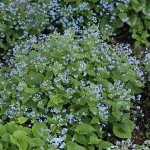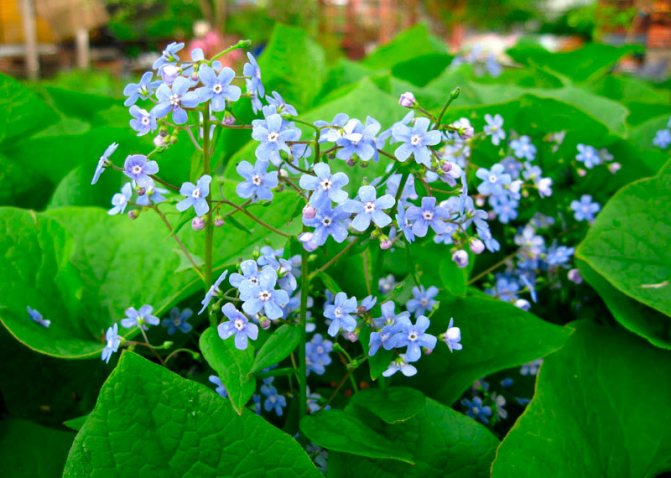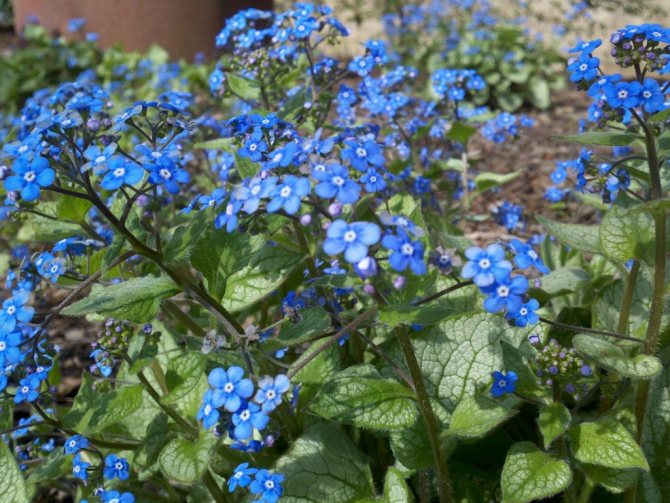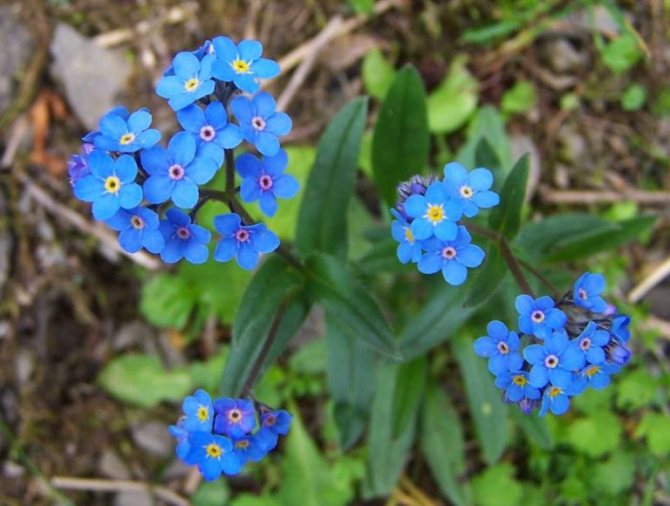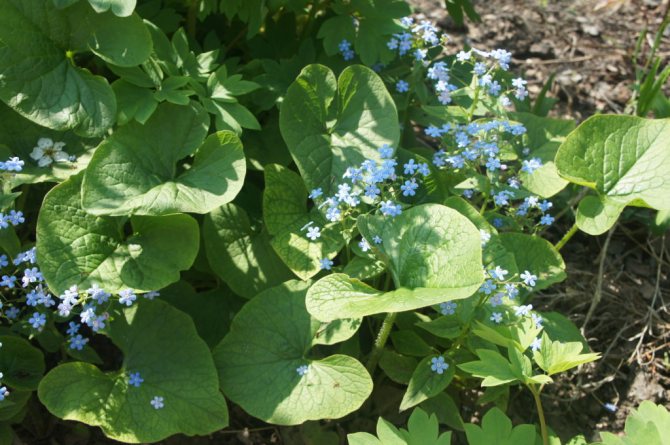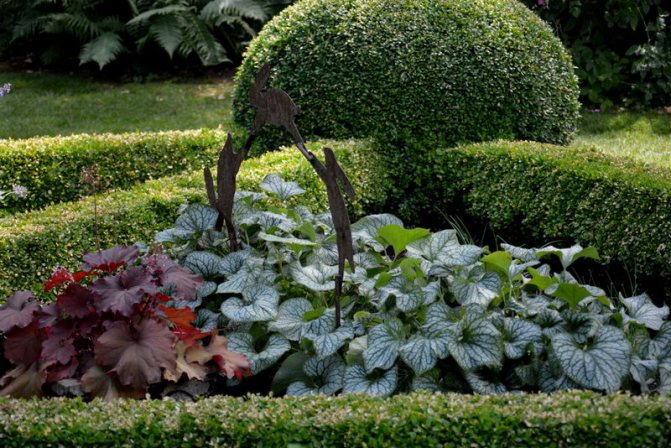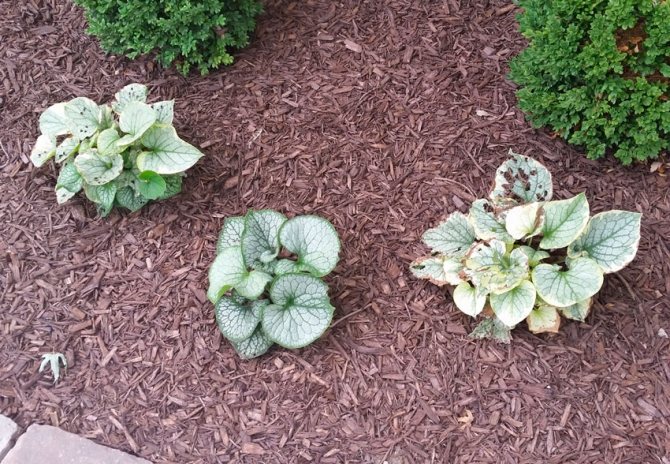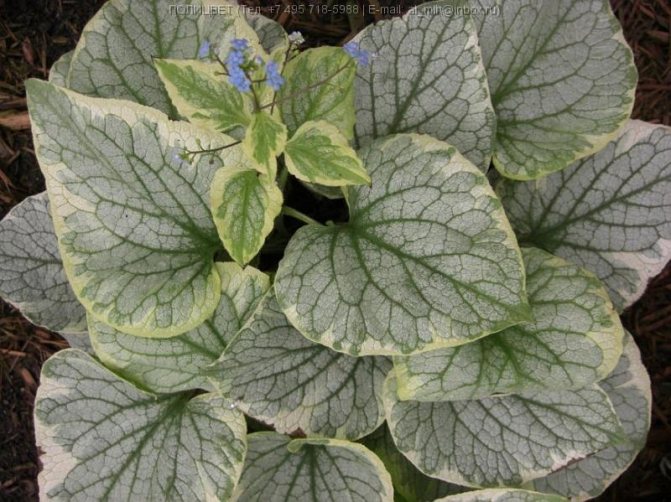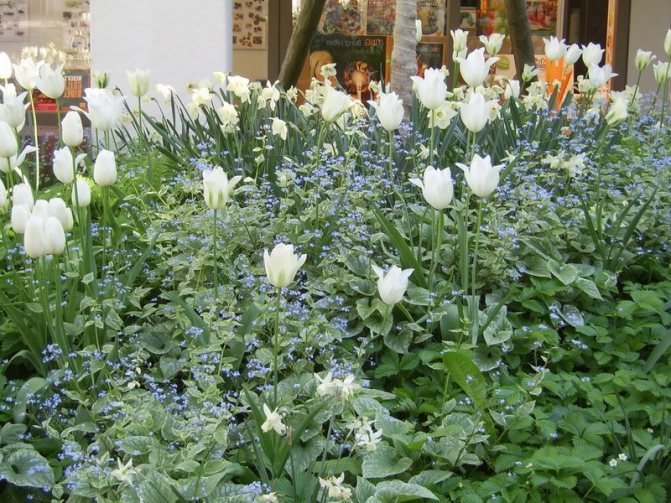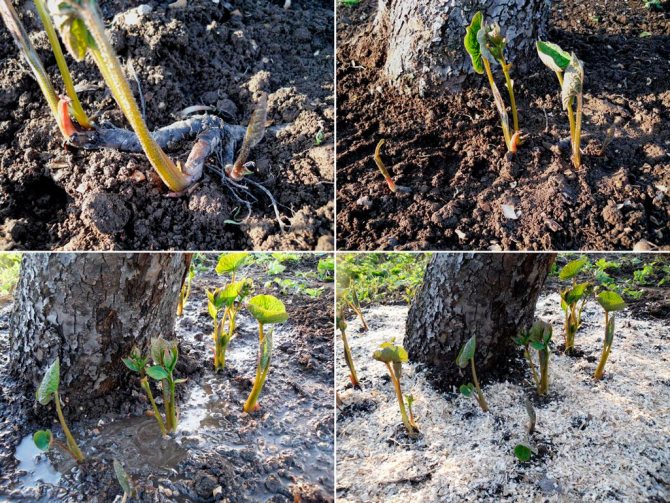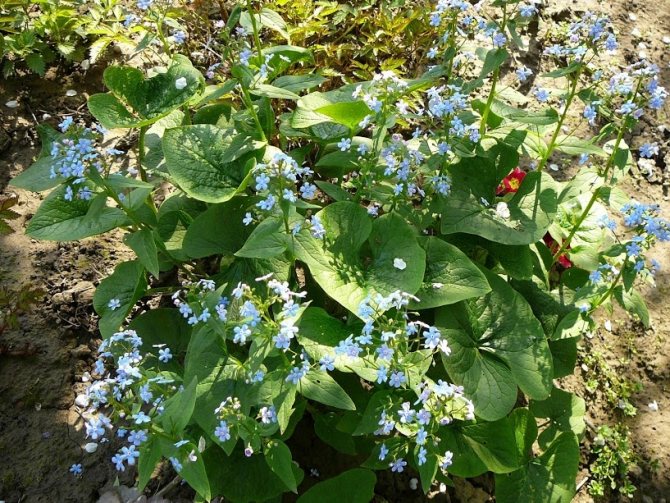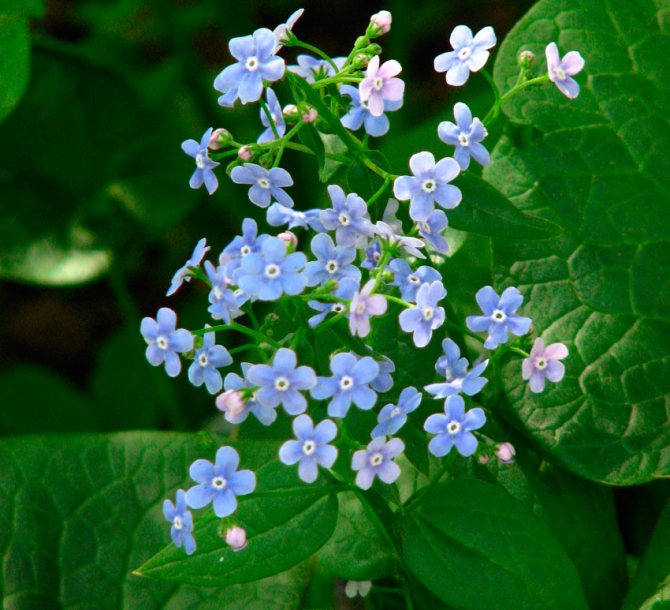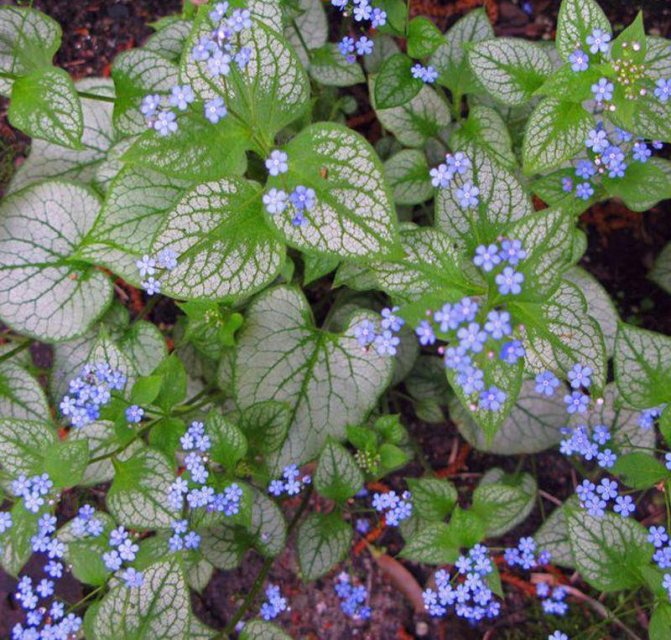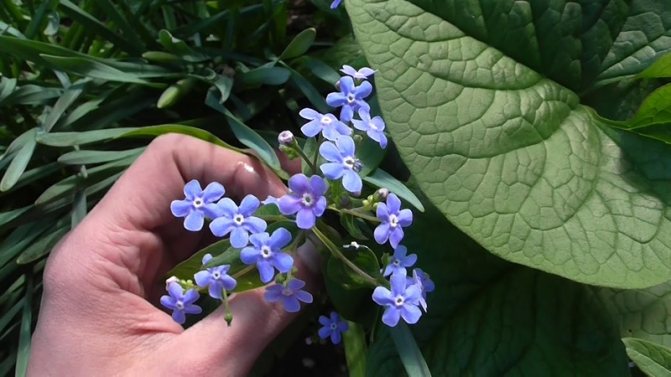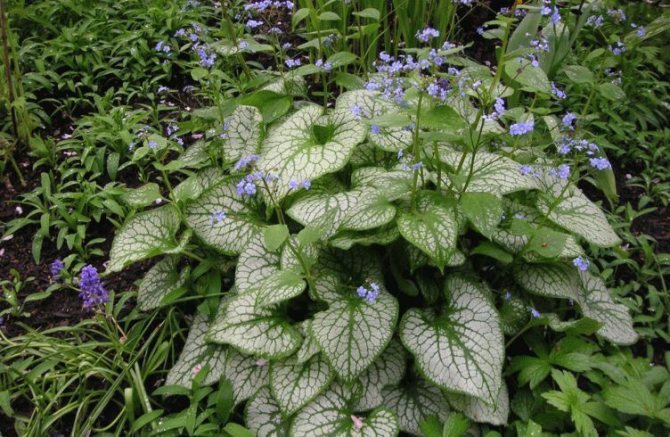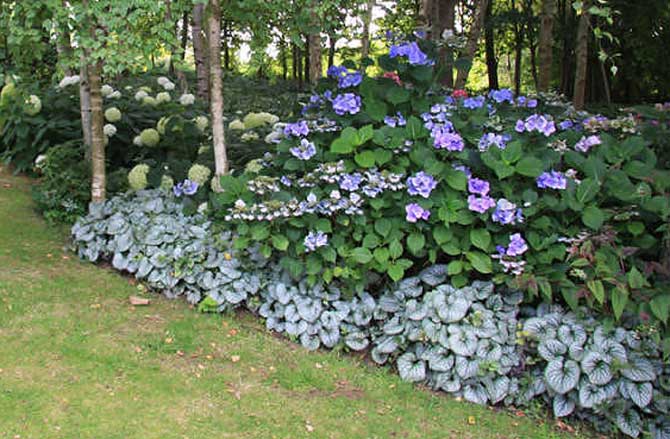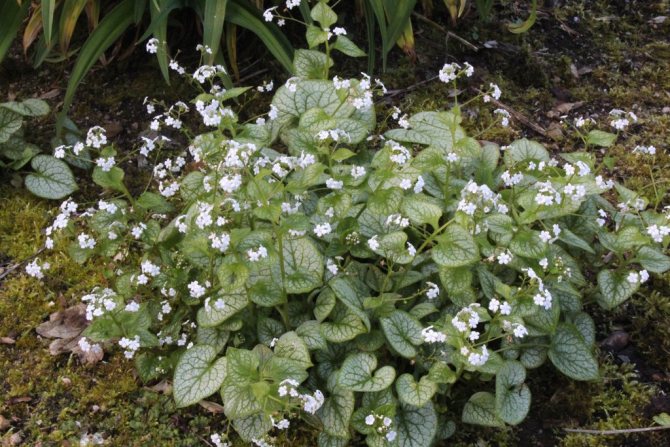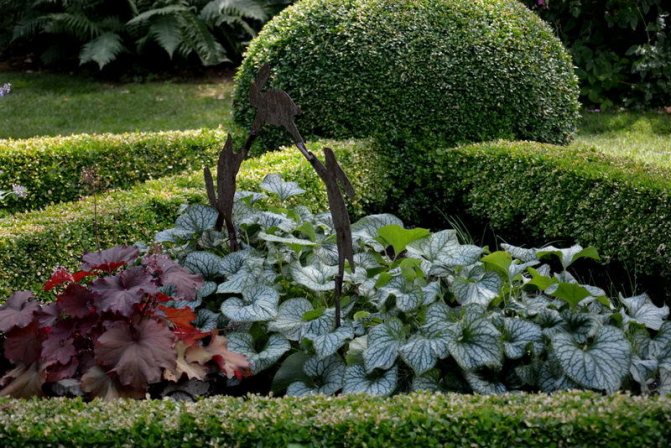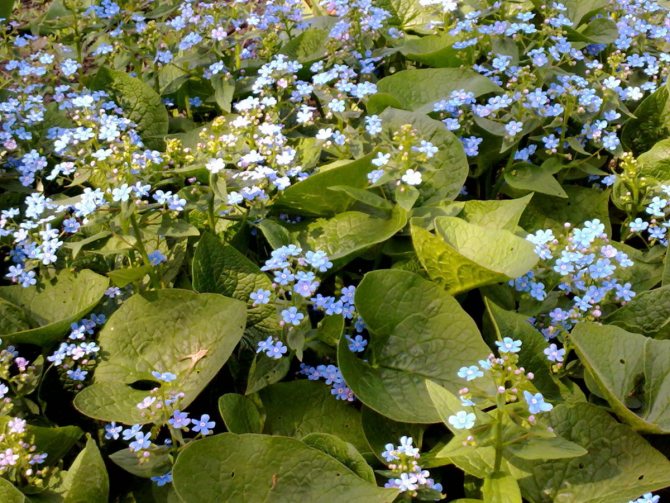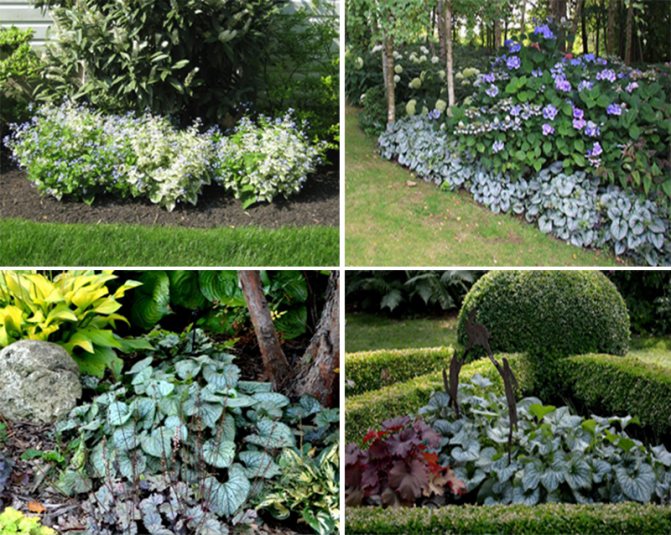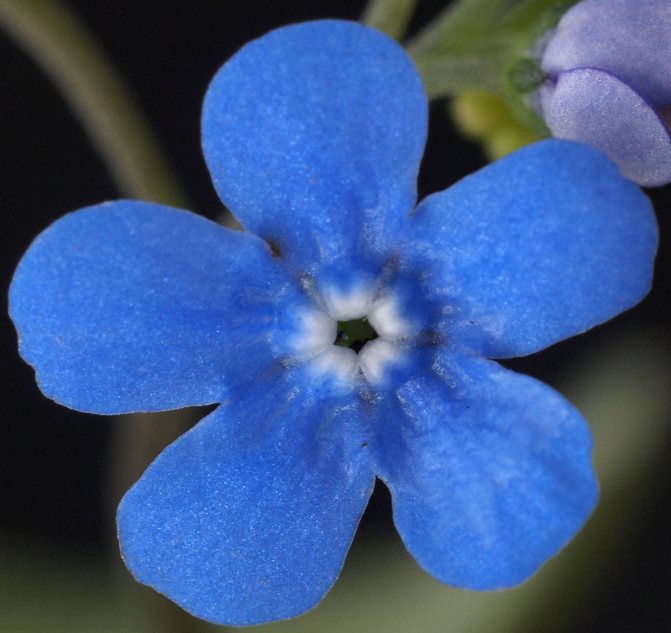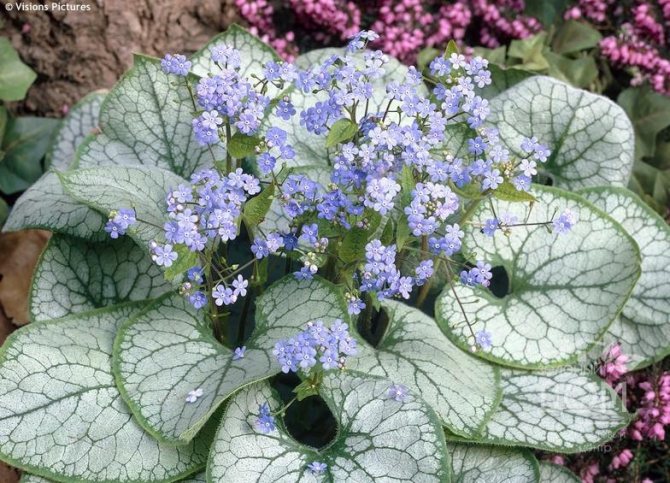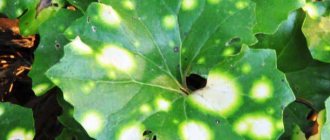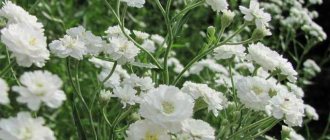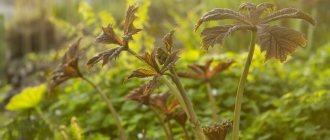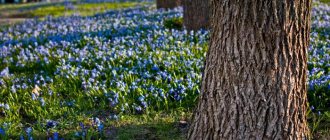A plant such as brunner or brunner (Brunnera) is directly related to the genus of herbaceous perennial plants of the borage family. This genus unites 3 species. These plants are found in natural conditions in Western and Eastern Siberia, the Caucasus and Asia Minor. This flower was named after the Swiss S. Brunner, who is known as a traveler and botanist. Only 2 species of brunner are cultivated, namely: Siberian and large-leaved. These plants are most often used to create borders and for stable decorative groups in mixborders.
Brunner large-leaved: description, popular varieties with photos
The birthplace of a perennial large-leaved herbaceous plant is the Caucasus. The bushes of the plant, depending on the illumination of the sun's rays, grow to a height of 40-60 cm. The stems have an erect appearance and light velvety along the surface of the stem.
Rounded green leaves are 20 cm long. Flowering takes place in May-June, large-leaved brunner flowers are collected in loose inflorescences of small pale blue flowers. Seeds ripen at the end of June.
With the help of this plant, flower beds, rockeries and rabatki are decorated. Looks good with plants such as hosta, heuchera and ferns.
The large-leaved brunner has many different varieties that differ in their leaves. The varieties are valued for the texture of the leaves, which retain their beautiful appearance for a long time.
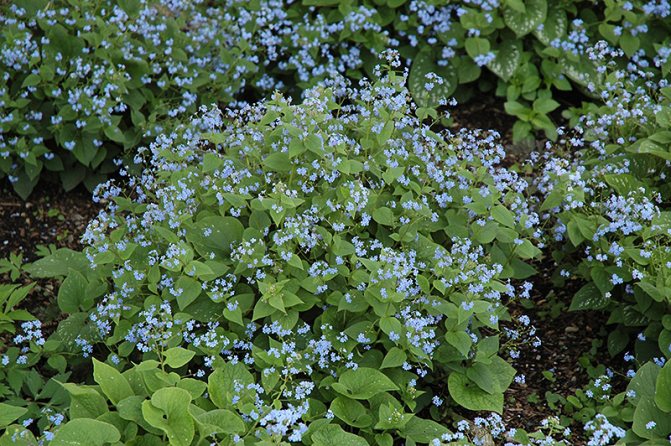
Brunnera macrophylla variegata
Brunner's large-leaved variegat is very popular, has large leaves, on which an uneven beige border is well traced. Leaves are textured. It prefers to grow in the shade and grows in a clearing 50 by 50 cm.
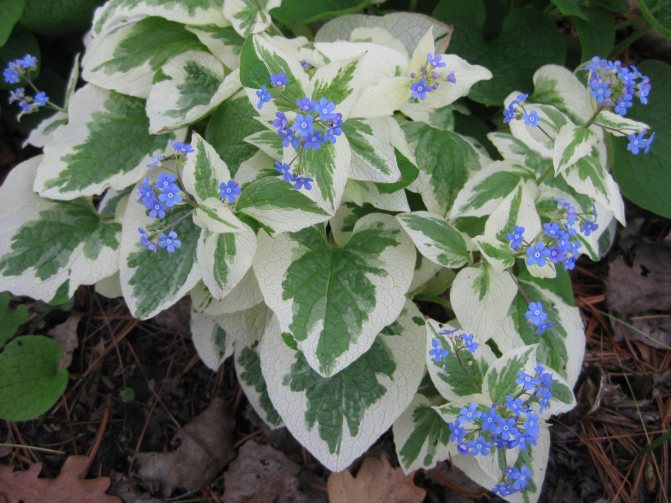

Brunnera macrophylla jack frost
Brunner's large-leaved Jack Frost has leaf plates with a pattern of frost, which occurs on the leaves in the fall after the first cold snap. The green tint has venation and part of the leaf surface. The height of the bush is 50 cm.
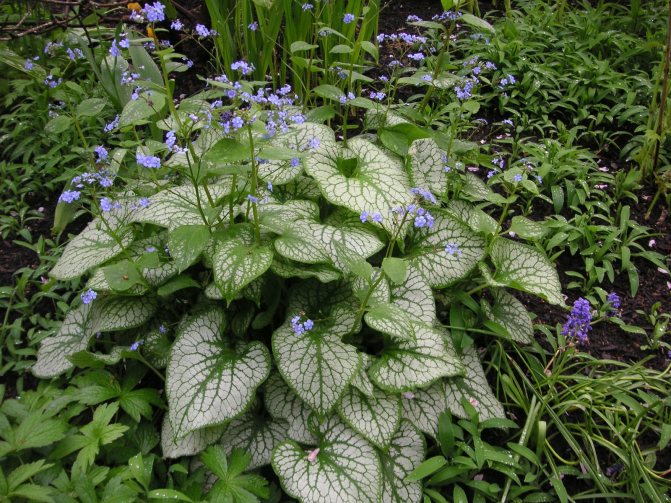

Brunner large-leaved Silver Hart
The species has large silvery leaves with well-defined green veins. Flowering takes place in small blue flowers that bloom in May-June. The height of the bush is 40 cm, a frost-resistant variety.
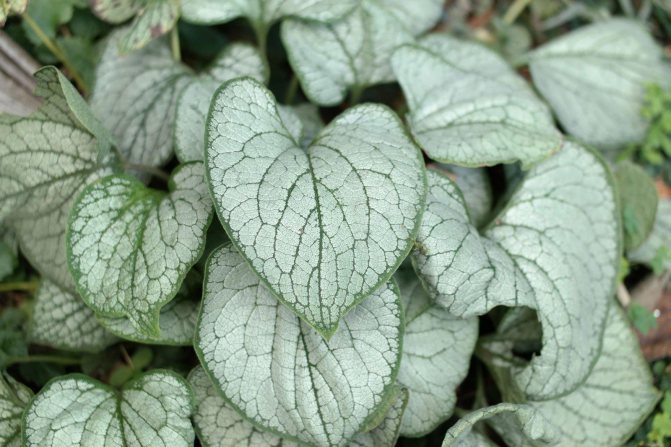

Brunner large-leaved Looking Glass
The pattern on the leaves is similar to Jack Frost's, but the silver is much more intense. Silver color like metal. Leaf venation is practically not highlighted in green. The bush grows to a height of 30 cm.
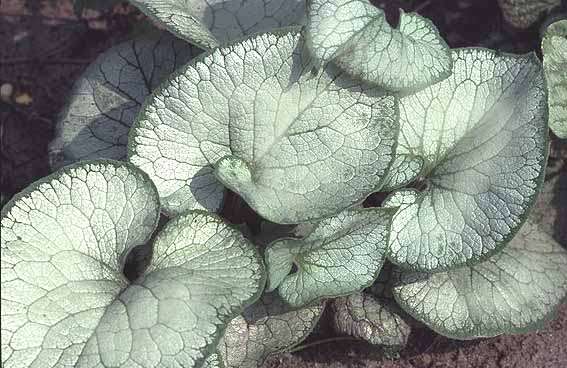

Brunnera macrophylla Alexander, s Great
The large-leaved Brunner variety Alexander Great was bred by the Belarusian collector A. Zuykevich. Large leaves have a silvery color and green veins. The bush grows taller than the other 50 cm.
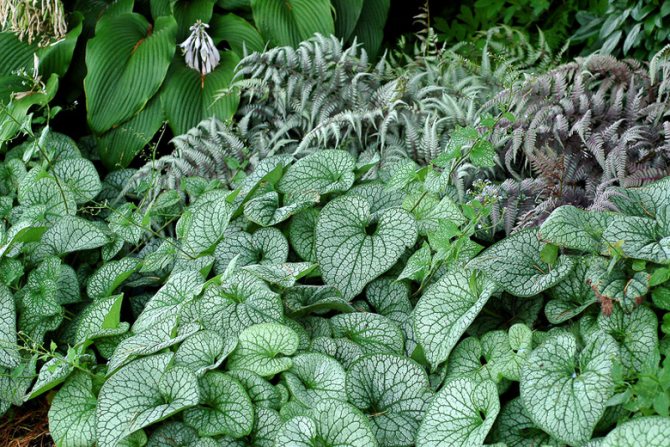

Like all plants, this perennial has several advantages:
- Unpretentious.
- It grows on any soil.
- Doesn't require very frequent watering.
- They are rarely transplanted.
- The survival rate in the new place is good.
- Flowering immediately after primroses, when the colors of the garden have not yet come into full force.
The large-leaved brunner has no flaws, because it is absolutely not demanding to care for, but is very good-looking.
Brunner's features
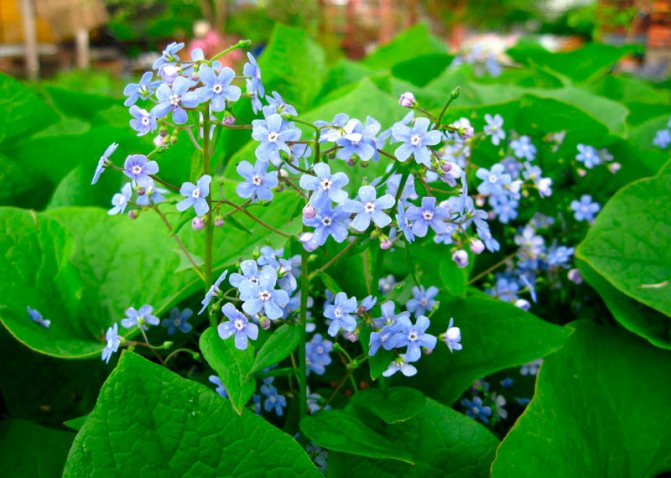

Brunera is a herbaceous plant that is a perennial, a bush in height can reach 45-50 centimeters. There is pubescence on the surface of branchy shoots.Large one-piece long-petiolate leaf plates have a wide-heart shape. Small blue flowers (0.5–1 cm in diameter) are outwardly similar to forget-me-nots, therefore such a plant is also popularly called a forget-me-not. Such flowers are part of paniculate or corymbose inflorescences. Flowering begins in April and lasts 4 weeks, possibly re-flowering in autumn. The flower of this plant differs from forget-me-not in that the spot inside it is painted not yellow, but white. The fruit is a nut. Such an undemanding plant in the care, growing, forms spectacular thickets. It is winter-hardy, but does not feel well during the dry hot period. Bruner can be grown for about 15 years without transplanting in the same place.
Landing
It is possible to plant large-leaved brunners in a new place using seeds. Or by acquiring young bushes grown in seedlings. You can also use part of the bush for planting after dividing the mother plant.
Sowing seeds
To get seedlings, you need to purchase seeds in a specialized store and start planting seeds:
- Loose nutrient soil is poured into the container, then the seeds are poured.
- The crops are moistened with a syringe, after which it is covered with a film for friendly germination of seeds.
- Seeds with two normal leaves are dived into separate containers and grown on a window before being transplanted into open ground.
IMPORTANT! Before planting in open ground, the seedlings must be hardened for 10 days.
Planting a seedling in the ground
Dig holes in the soil and add compost or rotted humus to them. The divided rhizome is laid out and covered with soil. After that, watering and mulching are carried out.
IMPORTANT! It is necessary to monitor the planted bushes and organize timely watering, which they need for successful adaptation.
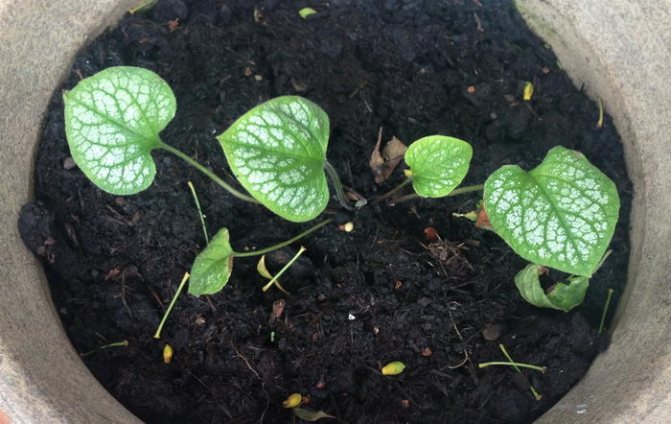

Brunner saplings
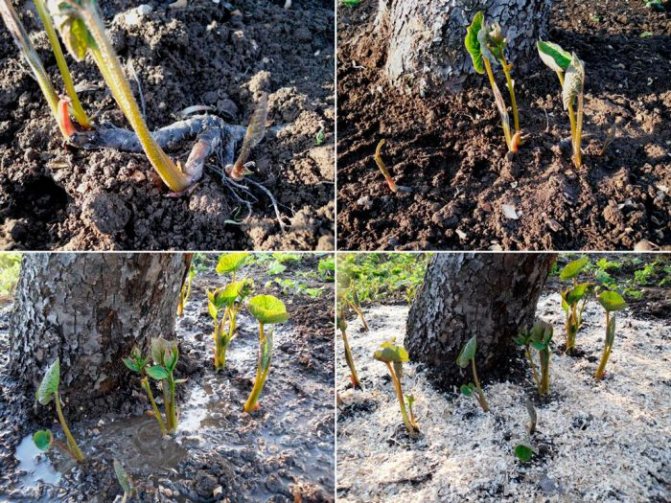

Planted plants
Diseases and pests
In general, both plant species are extremely rarely affected by pests and diseases, but in long rainy periods there is a risk of infection of the Siberian brunner with brown spot and powdery mildew, the large-leaved species is more resistant to these ailments. The forget-plant is attractive to aphids, whitefly, miner moths and slugs.
It is easy to fight ailments - pests can be driven out by spraying, and fungal diseases disappear with the timely removal of the affected parts of the bush. By the way, the brunner in the garden can be called a certain guarantee of the absence of mice, because the succulent roots of the plant attract rodents, but for them the roots are poisonous.
Care rules
Fertilizers are applied only in early spring. You can use rotted organic matter or apply complex fertilizing.
Watering is organized in such a way that the leaf mass does not lose turgor. The higher the ambient temperature, the more water is needed for irrigation.
When after 5-6 years the bushes grow, they can be divided into small parts, limiting their growth in width by this operation.
Simple rules for quality care:
- In the spring, the plant is fed with organic matter.
- Faded buds are removed during the flowering period.
- Watered during the summer.
- The bushes are mulched so that the water evaporates slowly and the bushes have enough moisture.
- For the winter, the bushes are not covered.
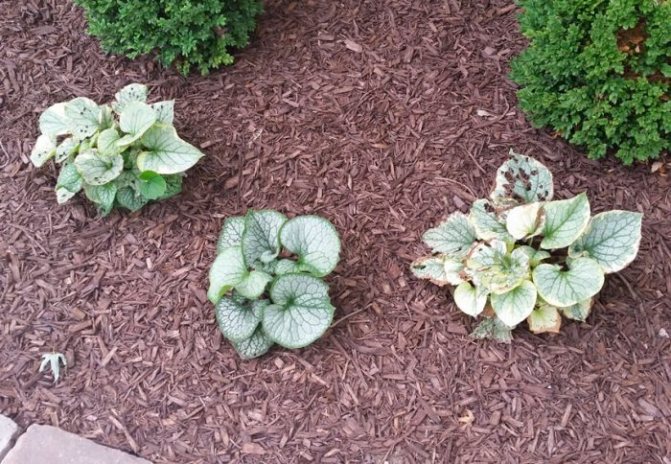

Mulching is a necessary care element
The species has good frost resistance, and only regions located at the latitude of the Moscow region cover the bushes with peat or spruce branches.
Growing seedlings
- You can try to grow Brunner seedlings - for this they are sown in bowls or containers with dense soil and placed in a refrigerator or under snow for stratification for 4 months.
- At the end of winter, the bowl is placed on the windowsill.
- The sprouts will appear in two weeks, but not all at the same time.
- With sparse sowing, they can not be dived, but slightly add soil to the container with seedlings.
- Then they are grown as ordinary seedlings, feeding them twice a month with liquid complex fertilizer.
- Such plants will be ready for planting in the garden with the onset of warm days. They tolerate the transplant painlessly.
Vegetative propagation (cuttings, dividing the bush) is most acceptable because of its simplicity, availability, ease. It also always retains its original maternal qualities. Seeds are used in the event that it is not possible to purchase planting material. Such reproduction is beneficial even if you have purchased a package with a mixture of different brunners, so you can simultaneously get many different varieties and colors.
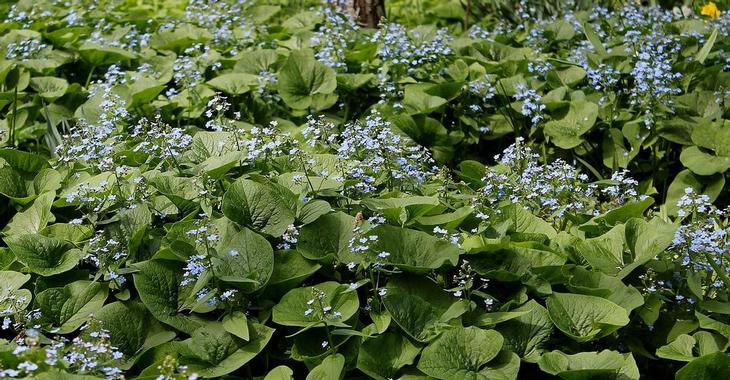

Gardeners' opinion
Brunner grows behind all the flowers for me, since I do not care for her plantings. I have had it in one place for more than 15 years and I have never specially watered or fed it. The only thing I do is periodically plant young bushes for my neighbors.
Elena, Ufa
My varietal brunner does not cause much trouble. I rarely water. But everything has to be weeded, that which was sown by self-sowing, as it grows without varietal characteristics.
Svetlana, Moscow
Brunner is a large-leaved, irreplaceable perennial that can decorate any garden with only minimal maintenance.
Brunner in garden design
Unpretentious perennials are always in demand in landscape design, the forget-me-not is universal in landscaping, it is beautiful, unpretentious and easy to care for.
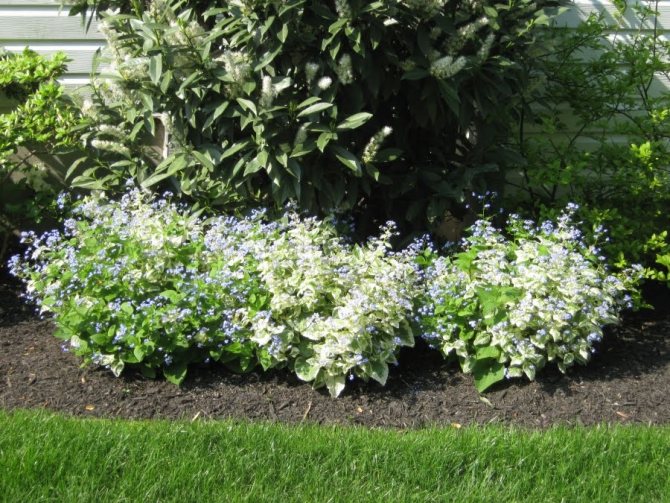

With Brunner, you can create a variety of spectacular compositions, her decorative bushes will successfully fit into any landscape projects. Siberian brunner is suitable for a shady garden, where fern, hosta, lungwort, hellebore, hydrangea, some varieties of juniper, astilbe, rogersia and geychera are good neighbors for it.
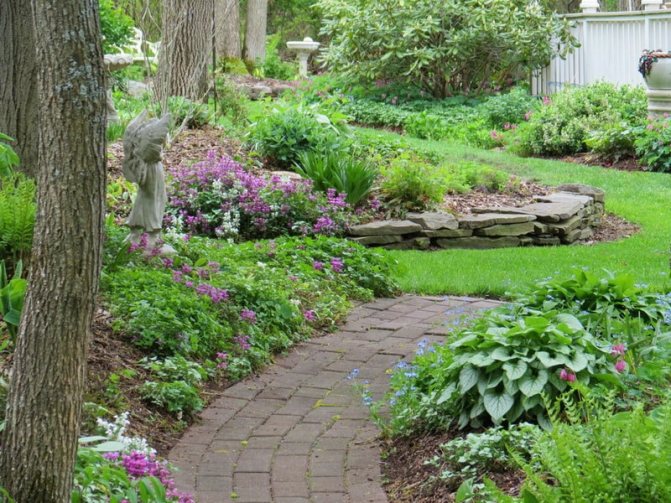

In the flower compositions of the Brunner, flowers such as primrose, Goryanka Colchis, ornamental onion, dicentra, hyacinths, spurge, doronicum, tulips, muscari, swimsuit, aquilegia, geychera and daffodils will make a good company.
When choosing companions, rely on shades of flowers - it is better to select plants with yellow, white, purple and blue flowers.
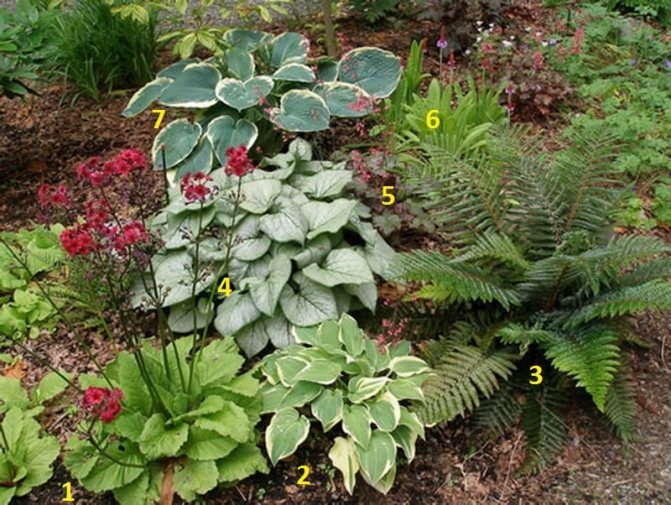

- Primrose 'Millers Crimson';
- Host ‘Mama Mia’;
- Mnogoryadnik polystichum polyblepharum;
- Brunner's ‘Looking Glass’;
- Geuchera ‘Raspberry Ice’;
- Orchid primrose;
- Host ‘American Halo’.
This moisture-loving perennial will successfully decorate the shores of various reservoirs. The large-leaved Brunner flower does not lose its decorative effect all season, so feel free to use it in permanent group compositions, and undersized species will effectively emphasize the path with a chic non-growing border.
End of flowering and preparation for winter
Brunner's large-leaved ceases to bloom in the summer, in July. Withered flowers should be cut off, leaving only the leaves. Leaves, unlike flowers, do not lose their beauty even before the onset of cold weather.
With the arrival of the cold pore, the brunner leaves should also be cut off, since they themselves will not fall off. After the leaves are completely cut off from the flower, it can be prepared for wintering. Brunner can spend the winter on her own, but additional help will not hurt her. It is enough just to mulch the soil with sawdust, leaves or humus.
Garden flowers Perennial flowers
Selection
Brunner Variegata, which was one of the first to be created, has decorative cream-colored specks on the leaves. On one bush, milk-cream and light green leaves with a yellowish stripe along the edge grow synchronously. The absence of chlorophyll affects them negatively, causing the formation of dark blots.
The variety was considered not too winning, which is why the growers were looking for a remedy for the situation.More recently, it was possible to bring out a new amazing species, called Jack Frost, which has become an adornment of flower beds for three seasons - from early spring to late autumn.
A half-meter bush with silvery leaves, marked with green veins and dark edging around the edges, looks like a very elegant bright spot on the lawn. It is recommended to combine this variety with neighbors of any green shades, but not variegated, for example, with ferns, the background of which allows the Brunner to look much brighter.
Brunner's Jack Frost perfectly wintering in the central regions of Russia. Reproduction takes place by means of seeds, by dividing the bushes. Success with this variety inspired the breeders to continue their work, resulting in 2 more species: Looking Glass and Silver Wings, whose name translates as "silver wings".
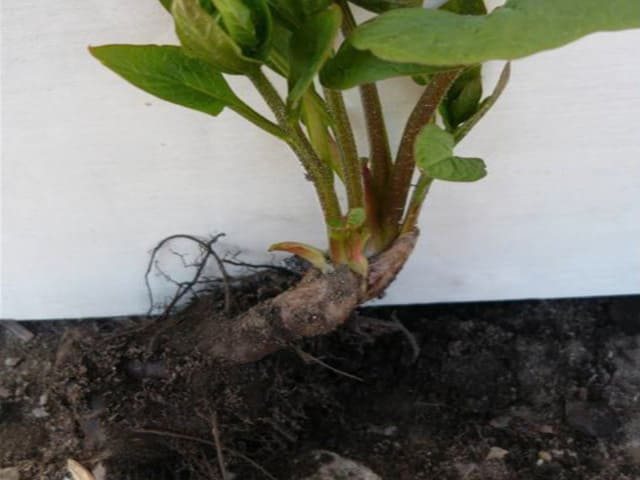

It features wing-like sweeping silvery strokes against a light green background at the edges of the sheets. With the goal of enhancing the decorativeness of the leaves, the breeders had to sacrifice the size of the flowers - they became even smaller.
But in the inflorescence, their number has increased, which gives the plant weightlessness. A feature of Hudspan Cream is a narrow strip of creamy white along the edges of the cupped leaves. In sunlit areas, they can be almost white. Aging foliage causes them to darken to brown, which forces them to get rid of.
Decorative application
Gardeners love Brunner for its unpretentiousness, decorativeness, it looks interesting as a green background for flowering plants. What are the use cases for perennials?
- In the curbs. Based on the fact that the bush is compact, grows quickly, keeps its shape well, it is planted along the edge of garden paths and flower beds, as a lower tier in raised flower beds.
- In mixborders. Luscious greens serve as a good background for tall flowering perennials, used in group plantings with other decorative deciduous plants (fern, horned goat weed, wild garlic). Like hosta, it grows well in shady flower beds.
- In rockeries, relief gardens. A subalpine type culture is planted as a ground cover plant in low, humid places, next to an artificial reservoir.
Brunner's Siberian is not so decorative, but the shade-tolerant culture is indispensable for the northern and shaded areas of the garden. Growing, it densely covers the soil, displaces weeds, forming a continuous green carpet.
Characteristics of culture
Brunner is a herbaceous perennial, it grows in a bushy shape, its height is up to 50 cm. There is a slight pubescence on the branchy shoots. Leaves are long-petiolate, heart-shaped. Flowers of a bluish tint in a volume of up to 1 centimeter, outwardly resemble forget-me-nots, therefore, the culture is often called a forget-me-not.
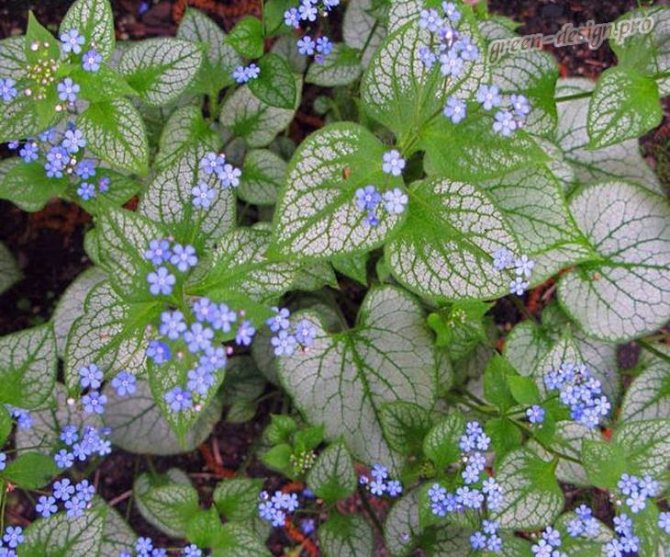

Ornamental variety Brunner - Jack Frost
Beautiful flowers bloom in mid-April, delighting the owners for 3-4 weeks. Under good climatic conditions, the culture can bloom again - in the fall. Brunner is resistant to frost, but does not like too high temperatures, so it should be grown in shaded areas. Without replanting the culture, it will be able to grow without changing the location for up to 15 years.
Growing and caring for large-leaved brunner
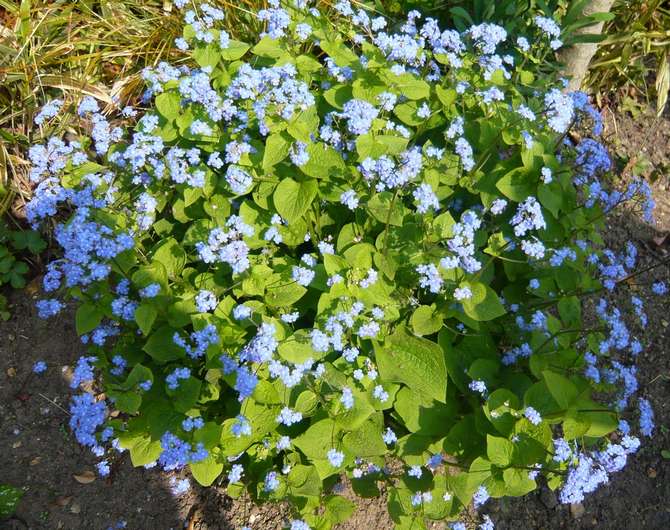

The plant is so unpretentious that it does not even need watering, if, of course, it is planted in a good place. The overgrown Brunner will not let weeds. But you still need to keep track of the weeds and do weeding if necessary. The only thing that will not interfere with the successful cultivation of Brunner is mulch in hot summer and winter.
It is strictly forbidden to dig or loosen the soil under the brunner - you can damage the roots, which are usually located close to the surface of the earth. Before wintering, it is better to cut off the aerial parts, leaving hemp about 12 cm long.
In the spring, you can scatter granules of complex fertilizer directly over the snow to accelerate the growing season and richer color of the leaves.
Content
It is easy to care for the plantings. However, its simplicity is limited. Breeding of large-leaved and Siberian species is different. Proper planting in a shady place in wet soil allows you not to worry about the first of them throughout the season, if not for the difficulties with weeds, which must be systematically destroyed. But the soil should not be loosened due to the shallow location of the root system. Watering and fertilizing the plant is also not required.
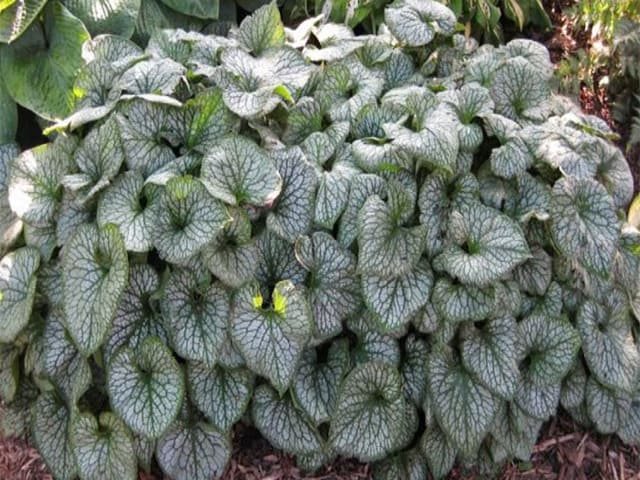

Brunner's Siberian will soon fade, its leaves dry up, they need to be removed so that in August fresh foliage appears on it again, which should remain until frost. Weeds are not dangerous for the Siberian species, since its dense thickets do not allow weeds to penetrate the root system and clog it. The forget-me-not does not need watering either, there is enough natural precipitation. An exception is made only in too hot summer, and when to water, the situation with its leaves will tell you.
Landscape design
Plants blooming in spring with beautiful leaves can decorate rockeries, alpine hills and paths. They go well with mountain goat weed, juniper, ferns, wild garlic. In mikboxers, brunner will favorably set off flowering tall perennials.
If there is a reservoir on the site, a lush bush can be planted near it and the shore will turn out to be airy green.
An unpretentious plant in care can be planted practically on any part of the garden, which it will decorate with its flowering in spring, and with beautiful green or colorful leaves in summer.
Brunner plant
We select neighbors
Hosts, ferns, rogers, astilba, heuchera, hellebore, lungwort are well suited.
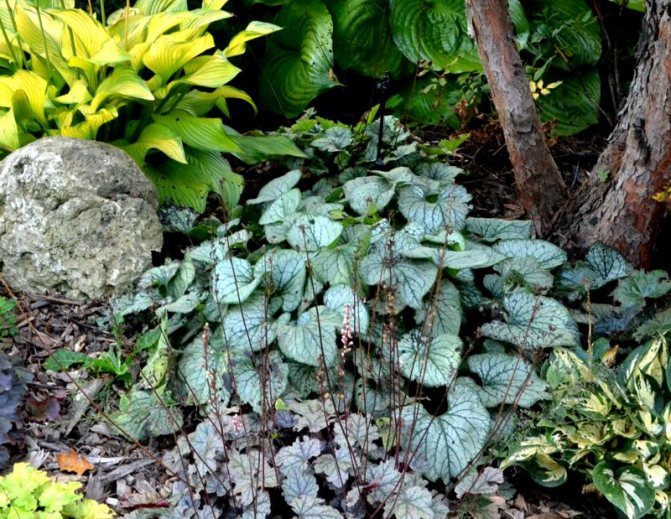

Brunner's large-leaved 'Jack Frost' with "partners" in the flower garden - hosts and heychera
<2019, Planting a Garden. All rights reserved.
Similar posts
In the shadow doesn't mean imperceptibly
Sedum is a perfect ground cover
Thyme
Bruner in the garden, or a story about those who are able to keep her company
A perennial brunera is a great option for landscaping complex areas of the garden, as well as creating a true miracle near a barbecue area, pool or gazebo. To do this, it is enough to pick up interesting plants in a company with a Bruner, the neighborhood with which she will be glad.
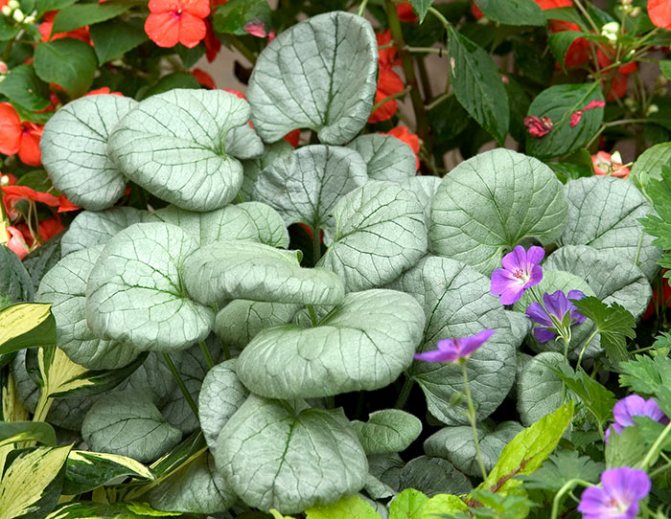

Brunera goes well with many other plants
Such plants can be:
- periwinkle, undersized salvia, ranunculus - on the first line;
- some of the perennials, the height of which will not reach 30 cm. An excellent option is tulips, lilies of the valley and even snowdrops, which are well suited to a semi-shady and humid place;
- tea or curly roses in the background. Bruner greens and roses will create a single gamut, but flowers will delight you with contrast.
The creation of landscape design in a certain style is a delicate and multifaceted matter. But in a few years, you can create a real natural masterpiece on your site, consisting of annual flowers and perennial plants, shrubs and stunted trees, even large trees. Why not?
And later, while enjoying relaxing in the garden, you will remember that it all started with a forget-me-not flower. A bush flower that I liked with the shades of foliage and cute flowers.
Site selection and suitable soil for Brunner
The plant is very suitable for an area that is illuminated by the sun in the morning, but in the shade in the afternoon.


In a completely shaded place, the shoots are stretched out, and the flowers appear sparsely and sparsely.
A completely sunny place will not work due to lack of moisture, unless the close location of the garden reservoir will save the situation.
On loams, Brunner grows without special care, additional watering and the introduction of nutrients. It is not necessary to fertilize good garden soil; compost is additionally embedded in the poor soil during the preparation of the site.
However, the introduction of fertilizers into fatty soil, especially fresh manure, often turns out to be an unsuccessful service for a flower - foliage grows actively and for a long time, but the root system remains poorly prepared for wintering.
This is not scary for a species specimen, it is more stable and tenacious, and varietal bushes often die.
Brunera large-leaved and forget-me-not, are there any differences?
Large-leaved Brunner grows mainly in the Caucasus Mountains. Therefore, the plant is often called "Caucasian forget-me-not". The plant is a sprawling bush with rough stems about 40 cm high.
The leaves reach 25 cm in length. They are heart-shaped with a pointed top. The size of small flowers does not exceed 5 mm. Dark blue flowers are collected in paniculate-thyroid inflorescences.
Brunner is often confused with forget-me-not. However, the flowers of these plants have significant differences. In the center of the Brunner flower there is a white spot, while the forget-me-not has a bright yellow spot.
Decorative types and varieties
Of the three types known today, only two are used in landscape design:
Brunner large-leaved (lat. B. macrophylla) grows in the Caucasus. It is a branched bush with a powerful superficial rhizome. Spreading leafy stems lengthen up to 40 cm by the end of flowering, they are pubescent, rough to the touch. Leaves are basal, oblong, oval-heart-shaped, pointed, two-colored - the upper dark green color is replaced by a grayish lower one. Inflorescences are paniculate-corymbose. Decorative from April until the first significant frost, when the leaves die off. During the season, the bush looks elegant, as new leaves appear constantly and regularly. Garden forms are valued for their wide beautiful variegated heart-shaped leaves.
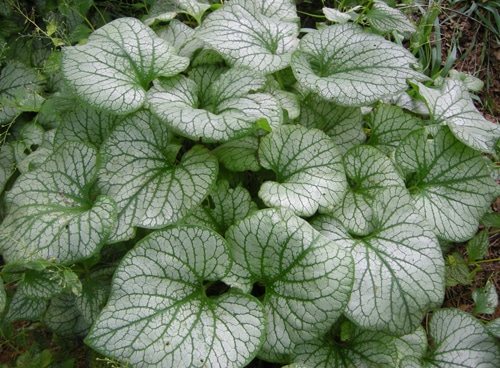

Brunner large-leaved
Brunner siberian (lat. B. sibirica) occurs in Altai. Outwardly, it is larger, more spectacular than large-leaved. It features a long rhizome, single stems with sparse pubescence, up to 60 cm in height. Instead of bushes, it forms dense deciduous thickets. After flowering, the leaves dry out, becoming covered with dark spots. New ones appear at the end of summer, and last until frost. As a forest plant, it prefers shady places with high humidity.
Description
Brunners are characterized by a thick rhizome, large wide-heart-shaped leaf blades, pubescent branched stems. Small corollas are collected in loose paniculate or corymbose inflorescences.
- The pistil and stamens are not protruding.
- The fruits of the forget-me-not are small dry nuts. They appear by the end of August.
- The height of the perennial is from 45 to 55 cm. The distribution area includes Asia Minor and Siberia.
- Blooming brunner beads decorate the garden for a month. The flowering period is in April-May. Among the distinguishing features, a white spot inside the flower is distinguished.
- An adult plant forms low thickets that do not require complex maintenance.
Additional advantages of Brunners include their winter hardiness and visual appeal.
Healing properties
Siberian brunner leaves are used in folk medicine. Decoctions and infusions are prepared from it. Infusions have anti-inflammatory and antipyretic effects. Broths are taken for constipation.
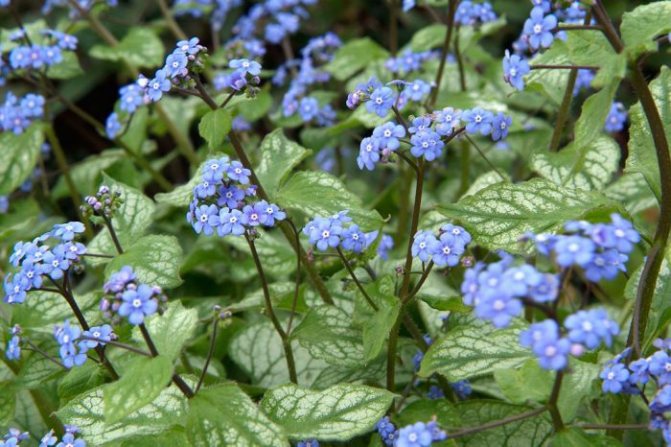

Gardeners speak well of the flower. Some claim they feel uncomfortable looking at the cute blue flowers. She is practically not looked after, but she pleases with her color.Sometimes the gardener does not visit the site for several weeks. Arriving, he will see the drooping leaves of the forget-me-not, water it, and again the flower generously shares its beauty. For this undemandingness and modest beauty, gardeners love her.
Breeding bruners
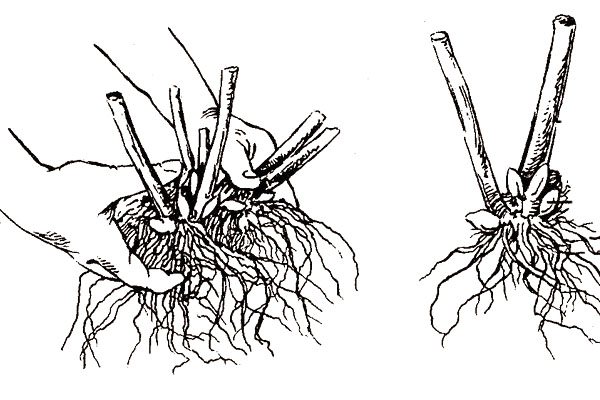

Brunner can be propagated in several ways. All of them are effective if you follow simple rules.
Breeding methods:
- dividing the rhizome;
- sowing seeds;
- in some cases, self-seeding.
The procedure for dividing the rhizome is recommended in August. It is during this period that a flower bud is formed. With successful rooting, brunner will be able to successfully overwinter and bloom next year. It is worth considering that the plant does not tolerate transplants well in the spring. It is possible to change the soil and planting site in spring only for the large-leaved brunner. But in this case, it is necessary to preserve as voluminous earthy lump as possible. This will allow the flower to take root faster.
Brunner's large-leaved has an insufficiently long rhizome, so it is propagated by dividing the bush itself. Each division should have an intact bud and a small area of the rhizome. Such a specimen is planted in a flower garden, in a specially prepared place.
In Siberian brunner, the rhizome has a branched shape, so the plant should be propagated by segments of the rhizome. Most often, a bush is dug up and divided into small elements. Each must also have a renewal kidney. The section is planted to a depth of no more than three centimeters, and then covered with earth.
Photo gallery of views
Name, origin, purpose
Brunner was named after Samuel Brunner, a Swiss botanist. This herbaceous perennial belongs to the Burachnikov family. People also call it the Caucasian forget-me-not. The plant received this name for the similarity of its flowers with forget-me-not flowering. However, Brunner and forget-me-nots belong to different families. And different types of perennials have different homelands.
In nature, Brunner's herbaceous perennial is of three types and grows mainly in the following regions:
- Forests and shady meadows of the Caucasus region. The most popular Brunner variety with large green leaves grows here. In the Caucasian species, the name was fixed - "large-leaved", and scientifically it is called Brunnera macrophylla.
- Altai, Western and Eastern Siberia - the birthplace of the Siberian Brunner. This is the second most popular type of brunner among gardening enthusiasts. The international name of the Siberian perennial is Brunnera sibirica.
- Countries of the East, such as Iran, Iraq, Turkey and Palestine, can also boast of the presence of brunners in the flora of their territories, but the eastern counterparts of the perennial are not cultivated, therefore, only the first two species will be discussed further.
Most often, Brunner is used when creating landscaping for shaded areas, as well as for curbs, rockeries, alpine slides and mixborders. This unpretentious plant blooms with a cloud of blue-blue flowers, has wide strong leaves, resembling a heart in shape.

